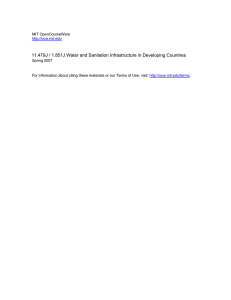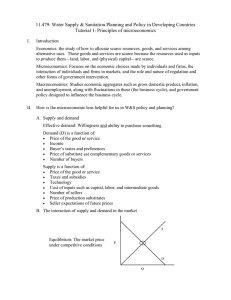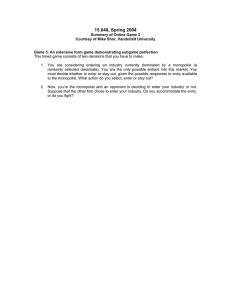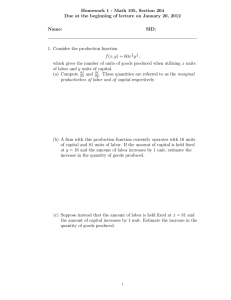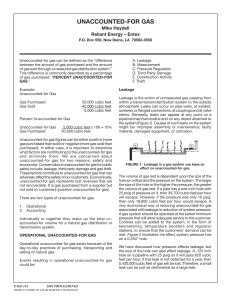11.479: Water & Sanitation Planning in Developing Countries
advertisement
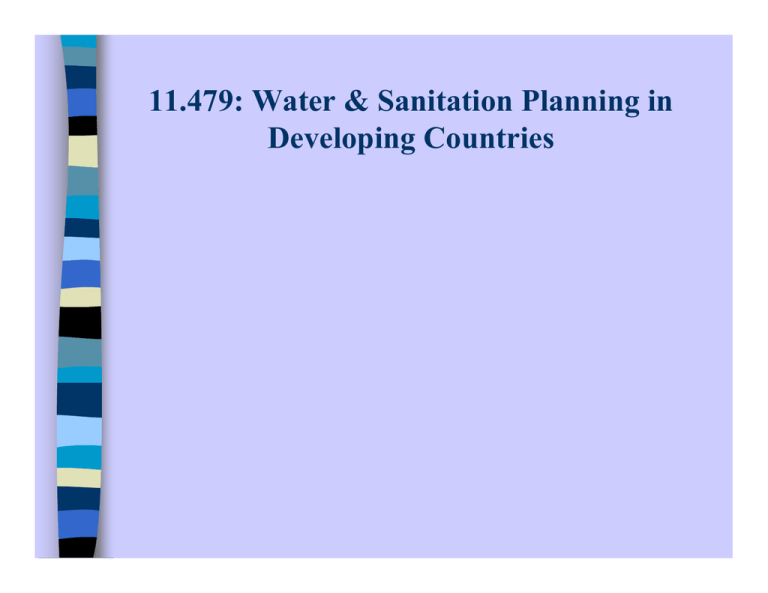
11.479: Water & Sanitation Planning in Developing Countries Objectives: Finish up last week’s discussion about women as a unique stakeholder group The “right” institutional arrangement for W&S service delivery Options for service delivery – Centralized versus decentralized – The public-private continuum Women as a unique stakeholder group Proposition #1: In general, women should be given particular consideration as a stakeholder group in water and sanitation planning. Proposition #2: In general, if a W&S project is planned properly, women’s considerations will be taken care of in the general planning process. Ernest’s concern Should W&S projects be used as a vehicle to promote women’s empowerment? Question of intent 2) The “right” institutional arrangement for W&S service delivery We know that the most efficient production of W&S services will occur in a competitive market setting, so long as market failures don’t exist. What are some common forms of market failure? • Public goods • Monopoly • Externalities What kind of services are W&S? Rival Non-rival Rival Non-rival Exclusive Private goods Club good Non-exclusive Quasi-public Public goods Exclusive Cars, houses, your lunch Bridges, swimming pool, movie theatre Non-exclusive Clean air, grazing land National defense, public health programs Do we have a public goods-type market failure? Monopoly A single firm provides the total supply of a product in a given market (‘price maker’), There are no close substitutes for the monopolist’s product, Barriers to entry—monopolist controls a strategic input (e.g., water source), legal barriers (e.g., monopolist has exclusive service rights), or economies of scale—make it very difficult or impossible for new firms to enter an industry. Do we have a monopoly situation in W&S? Externalities Externality: An uncompensated impact on wellbeing created by production and/or consumption activities The greater the value of an externality, the less accurately the price reflects the ‘true’ value of the good or service—and the less efficiently it will be provided by the market. What are the implications for W&S policy and planning? Social goods? Water & sanitation are often labeled as being “social goods.” What does that mean to you? Is efficiency our only objective as W&S planners? State involvement in W&S service provision Municipal department: W&S staff are not managed separately from other municipal staff. Accounts from all departments are integrated. Utility department: W&S has managerial autonomy, but no budgetary autonomy. Public utility: Has managerial, financial, and legal autonomy. Budget and assets are ‘ringfenced’ State involvement in W&S service provision Advantages? Focus on social goals such as universal service Possibly better integration of W&S with other sectors (e.g., health and environment) Long planning horizon should mean better resource stewardship Disadvantages? Political imperative to underprice: Unsustainable Non-service-related goals divert resources Few incentives to innovate, cut costs, be responsive Planning cycles timed to elections So… Is there any a priori reason to prefer a market versus a state allocation mechanism for W&S services? Instead, let’s focus on what we want from our service provider—the institutional arrangement that will be most likely to meet these objectives will vary from case to case. Trends in institutional arrangements for W&S service delivery in developing countries Historically, the W&S sector has been highly centralized and controlled by the state Two major changes over the past couple of decades are decentralization and privatization Decentralization: What are we hoping to achieve? • Heighten accountability: In what way(s)? Closer to users—social norms and pressures work better • Better understanding of what users want (still may not provide incentives to provide what users want, however) • Possibly decrease costs Does it work? What do the case readings that you’ve completed thus far suggest? What about your own experience? What are some of the biggest challenges in decentralized service delivery? • Capacity • Incentives Privatization: A continuum, not an ‘either/or’ choice Type of PSP arrangement Asset ownership Service or management contract Public Public Public Lease Public Public Public& Private Concession Public Private Private BOT & variations Public& Private Private Private Divestiture Private Private Private Private & Public Private Private Independent service providers Responsibility for capital investment Commercial risk Small-scale independent providers: The ‘other’ private sector Where is private-sector participation (PSP) happening in developing countries? Why? Private participation in water and sewerage in developing countries, by region, 1970-97 East Asia and The Pacific Europe and Center Asia 15% Sub-Saharan Africa 31% 8% 4% 42% Latin America and The Caribbean PROJECTS Figure by MIT OCW. Middle East and North Africa Projects versus investment TOTAL INVESTMENT Middle East and North Africa East Asia and The Pacific 13% Europe and Central Asia 33% 6% 48% Latin America and The Caribbean Figure by MIT OCW. Sub-Saharan Africa (0%) Why might we want to increase private-sector participation in W&S service delivery? Access to capital markets Technical know-how/capacity Attention to efficient use of funds More accountability / responsiveness to households (?) Get out of the ‘low-level equilibrium’ (Spiller & Savedeoff) What’s the evidence on whether these objectives have been met with PSP? Location Year & form of PSP initiated Buenos Aires, Argentina 1993 Concession Santiago, Chile 1989 Concession & service contracts Manila, Philippines 1997 Concession Indicator Values Unaccounted-for water* 1992: 44% 1998: 34% Employees per 1000 connections 1992: 6.4 1995: 3.3 1998: 1.7 Unaccounted-for water 1990: 28% 1994: 22% Employees per 1000 connections 1993: 2.1 1994: 1.9 Unaccounted-for water 1997: 58% 2001: 52% Employees per 1000 connections 1997: 8.5 2001: 4.1
